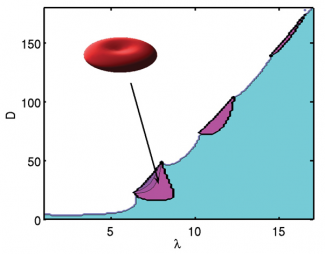Pancakes of Bose-Einstein condensates (BECs) of polar molecules are repulsive and potentially unstable. However, the physics of these dipolar condensates is delicious, according to research associate Shai Ronen, graduate student Daniele Bortolotti, and Fellow John Bohn. The JILA theorists recently studied BECs with purely dipolar interactions in oblate (pancake) traps.
The researchers discovered that if you keep adding more and more atoms to dipolar condensates of 52Cr, the condensates will eventually become unstable and collapse into a blob of metal after ejecting high-energy atoms. However, the flatter the pancakes (traps), the more atoms they can hold before the condensate collapses. This relationship is evident in the figure at right. As the trap becomes flatter (moving to the right along the horizontal axis), the number of atoms present in a stable condensate increases (vertical axis). In the figure, the blue area is the region where stable condensates form, while the white area is the zone of instability, where collapse is inevitable.
The theorists were surprised to find that, under certain circumstances, the wave function of a dipolar condensate starts looking a whole lot like a red blood cell, with a region of lower density in the center of the gas. This phenomenon repeats itself in a distinct pattern as the trap becomes increasingly oblate, as shown in the figure. The researchers believe this behavior is caused by repulsive long-range interactions of the atoms in the condensate. What they don't yet understand is why most of the time, the dipolar condensate has a single maximum in the center, but sometimes it morphs into the red-blood-cell shape, with its maximum density along a ring.
Interestingly, the two different condensate shapes collapse in different ways. When a "normal" condensate begins to collapse, density fluctuations move out symmetrically from the center like waves. In contrast, a red-blood-cell-shaped condensate begins to exhibit azimuthal density fluctuations around its perimeter, breaking the cylindrical symmetry and causing the ring to buckle. Explaining these and other exotic behaviors of dipolar condensates should keep theorists busy for some time. At the moment, they're predicting that sometime soon, experimentalists will observe dipolar condensates shaped like red blood cells. - Julie Phillips




